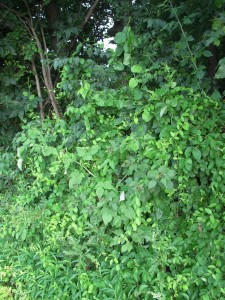For a printable pdf version of this information, check out our invasive species fact sheet.
Invasive species are becoming an increasingly worrisome problem both in Pennsylvania and throughout the globe. Invasive species do exactly what their name says- invade landscapes where they do not belong, choking out the native species that support the ecosystem. That is why we must all be responsible and proactive when it comes to keeping invasives out of our native landscape.
How do species become invasive?
Invasive species can be introduced to an ecosystem accidentally or intentionally. Introduction can be through the movement of products, for example globally on ships or regionally by taking infested firewood across state lines. Invasive species can also be introduced by using a non-native plant to landscape an area, which will then outcompete other species and spread on a large scale.
Once an invasive species is established, it can have huge effects on the local environment. Unlike native species, invasives are imported into their new environment without their diseases, pathogens, and predators, so their populations grow at rapid rates. Because of this, it is easy for invasives to outcompete natives and take over an area.
Common Invasives in PA
Plants:Multiflora rose, mile-a-minute weed, Japanese hops, tree-of-heaven, garlic mustard, and many more.
Insects:Emerald ash borer, Japanese beetle, gypsy moth, Asian longhorn beetle, hemlock wooly adelgid, and more.
Aquatics:zebra mussel, rusty crayfish, Asian carp, mudmat, water chestnut, and many more.
Prevention
The most important way to manage invasive species is to prevent them from entering the landscape. Ways to do this include landscaping with natives, cleaning camping and boating equipment, not moving firewood, and becoming aware of invasives that are common in your area.
Removal
If an invasive is found on your property it is important to remove it before it is given the opportunity to reproduce. For plants, this can be done either by physically removing it with tools or by applying herbicides. Once an invasive is removed, replace it with a native so that another invasive cannot occupy that niche.
Programs
USDA NRCS
The USDA NRCS can offer technical and financial assistance for managing invasive species. To learn more, visit their site here.
Web Resources
Comprehensive Resources on Invasive Species: Prevention, Identification, and Management
Invasive Plants in Pennsylvania
Invasive Species Council Resources
Pennsylvania’s Field Guide to Aquatic Species
Interested in managing invasive species on your property?
Contact:
Diane Oleson, Penn State Extension
717-840-7429, djo13@psu.edu

